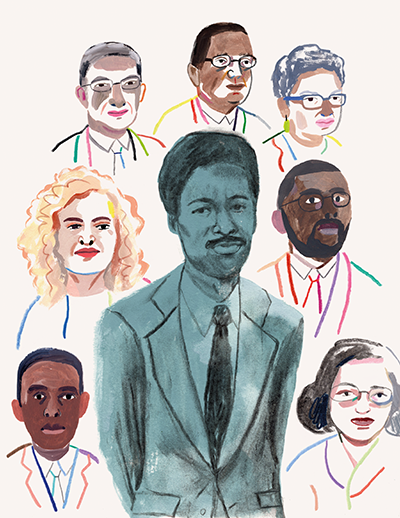The Tactician
A political science major, Wade’s true passion bloomed in the nascent political movement among the College’s African-American students. Tuffy Simpkins spells out this moment of change, around 1965, as enrollment of students of color hit a new tipping point: “When I got to Amherst, there was a weird rule that black students wouldn’t gather together, wouldn’t be more than three to a group. And that was because the whole idea was to integrate yourself.” As the student body spiked from the standard eight African-American students to upwards of 25, there was power—and comfort—in numbers.
“The burden was on us to integrate and be involved with everybody,” says Simpkins. “We just relieved ourselves of that burden. We didn’t have to disperse ourselves among everybody. We were going to sit and enjoy ourselves, and be with each other. And if anyone wants to come over and sit with us, fine, that’s great.”
This burgeoning cohesion led to an “intensification of something,” as Simpkins says, which led to the formation of a student organization that started out mostly social, as the Five College black population (also growing) organized dances and parties. “These were soul gatherings, lots of celebrations of Motown,” recalls Johnson. “Before that, the average campus party ended with The Beach Boys. That was not where we were coming from.”
Trevor Bryan ’67 recalls the backlash that resulted. These soul gatherings became “a point of consternation for some of the white students,” Bryan says, and The Amherst Student ran editorials decrying such supposed self-segregation. “We had to convince them it was social and there was a need for that.” Indeed, African-American students countered that, if Jewish students had Hillel and Catholic students the Newman Society, why couldn’t they also forge an affinity group?
“It was about ending the isolation,” says Johnson, “and then social identity became more prevalent.” The African-American cohort at Amherst, of course, wasn’t monolithic: “We ran the gamut from those completely in favor of nonviolence to those a lot more in favor of Malcolm X’s viewpoint.” Besides which, “we were the first group of black kids who had not come from the moneyed black class,” adds Johnson, whose mother was a maid. He and Wade, and several friends, connected over their working-class roots. Most of Amherst’s black students, before then, had fathers who were judges, doctors, professors.
At some point, African-American students planned a protest and President Calvin Plimpton got wind of it. He told Simpkins he did not approve; it was too rogue. Simpkins went to Wade, trying to figure out the next move. “Harold sat back and he stroked his chin and he said, ‘This is what you got to do: There’s this organization, Students for Racial Equality. It was very active before, but now it’s just a shell. It only has a president. And the president is really functioning off-campus. But if we all join, we could just ask the president to leave. We would have a mailbox, we would have a budget, we would be within a structure right away.’”
This was vintage Wade: acting behind the scenes, using institutional tools to retool the institution. And, indeed, the initially mostly white SRE became the placeholder until a more robust organization could launch. “Harold was clever at doing things that are good,” says Simpkins. “He didn’t use guile for anything bad.” Meanwhile, Wade and other SRE members recruited African-American upperclassmen who had a good rapport with Plimpton, and asked them to try and win him over.
Perhaps six months later (everyone’s memory is fuzzy), feeling the climate was right, Wade encouraged Simpkins to give a speech at a morning session at Johnson Chapel, with Plimpton present. Simpkins stood up and movingly traced the heritage of African-Americans at the College on up to that very day (a topic already Wade’s “obsession,” recalls Bryan). He declared that the time had come for Amherst’s black students to formally establish their own advocacy group, not build one on the scaffolding of a formerly white-dominated precursor.
Then Simpkins said, “The masquerade is over: we are the Afro-American Society.” Plimpton was so moved, he had tears in his eyes.
Using history as motivator, as explainer, as justifier: this became Wade’s signature. He knew how much heritage and context mattered and, as such, decided to back Simpkins over Johnson to become the first president of the Afro-American Society. It was a calculated move, or maybe it was par for the course, picking the more mainstream candidate. “Harold was unique in the sense that he tried to bridge the gap between all the people at Amherst,” says Jacques Cook ’67, the son of Mercer Cook ’25, a French professor who became the ambassador to Senegal and gets many pages in Black Men of Amherst.
Johnson, who went on to become a lawyer specializing in prisoners’ rights, perched on the more radical end of the spectrum (he’d often heard Malcolm X speak a few blocks from his home in Harlem). Yet Simpkins, who went on to become a physician and surgeon who also specialized in violence prevention, came from a family that had sacrificed much. White supremacists had—twice—bombed the Simpkins’ homes in Shreveport, La., as his father gained a higher profile in the civil rights movement.
Wade understood the heft of that personal history, and he always had the continuum in mind. He began digging into the backgrounds of Amherst’s black alumni, from Edward Jones, who graduated in 1826; to Charles Hamilton Houston ’15, who hammered out the legal foundation for Brown v. Board of Education; to Charles Richard Drew ’26, who discovered the chemical method for preserving blood.
This history didn’t need to be relegated to scholarly obscurity, however. It could also enrich on a more accessible plane. Thus Wade’s first widely circulated publication, the College’s original recruiting pamphlet for African-American prospects. Its tone? Modern, proud, personal. Its title? The Black Student at Amherst.


